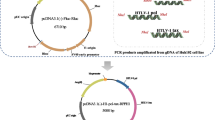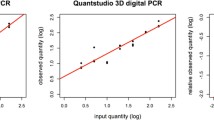Abstract
Quantitative viral load monitoring is an important indicator of prognosis in human immunodeficiency virus type I (HIV-1). PCR-ELISA as a quantitative method is proven to be sensitive and specific for quantification of HIV-1. Extracted DNA of thirty seropositive and twenty seronegative individuals which were confirmed by ELISA and western blot were amplified with digoxigenin-labeled nucleotides; and then in ELISA procedure biotin-labeled probes were hybridized to the PCR products. Diluted PCR products were analysed by electrophoresis and ELISA methods. The observation revealed that combination of nested-PCR and ELISA leads to a sensitive and specific identification of three copies in HIV-infected; the specificity and sensitivity were 95% and 96.7%, respectively. In conclusion, PCR-ELISA was 10 fold more sensitive than nested-PCR. This study developed a high sensitive PCR-ELISA to assess the quantification of proviral DNA load in the most relevant case of HIV-1 subtype. The reproducibility and reliability of this high-throughput test makes it appropriate for general laboratories to use for quantification of viral load and clinical diagnosis.
Similar content being viewed by others
References
Global HIV/AIDS Response: Epidemic Update and Health Sector Progress towards Universal Access, Geneva: WHO, 2011.
Metcalf, J.A., Davey, R.T., and Lane, H., AIDS: Etiology, Diagnosis, Treatment and Prevention, 1997, pp. 177–195.
Bhagavati, S., Ehrlich, G., Kula, R.W., et al., N. Engl. J. Med., 1988, vol. 318, no. 18, pp. 1141–1147.
Schito, M.L., D’Souza, M.P., Owen, S.M., et al., J. Infect. Dis., 2010, suppl. 1, pp. 1–6.
Hermle, J., Anders, M., Heuser, A.M., et al., BMC Biotechnol., 2010, vol. 10, pp. 32–44.
Lambert, J.S., Harris, D.R., Stiehm, E.R., et al., J. Acquir. Immune Defic. Syndr., 2003, vol. 34, no. 5, pp. 512–519.
Barletta, J.M., Edelman, D.C., and Constantine, N.T., Am. J. Clin. Pathol., 2004, vol. 122, no. 1, pp. 20–27.
Locateli, D., Stoco, P.H., de Queiroz, A.T., et al., J. Med. Virol., 2007, vol. 79, no. 10, pp. 1455–1463.
Novitsky, V., Wang, R., Bussmann, H., et al., PloS One, 2010, vol. 5, no. 4, p. e10148.
Demetriou, V.L., van de Vijver, D.A., Kousiappa, I., et al., PloS One, 2010, vol. 5, no. 6, p. e10976.
Beloukas, A., Paraskevis, D., Haida, C.J., et al., J. Clin. Microbiol., 2009, vol. 47, no. 7, pp. 2194–2199.
Pasternak, A.O., Adema, K.W., Bakker, M., et al., J. Clin. Microbiol., 2008, vol. 46, no. 7, pp. 2206–2211.
Misiani, M., Venturoli, S., Gallinella, G., et al., Nat. Protoc., 2007, vol. 2, no. 10, pp. 2502–2510.
Calmy, A., Ford, N., Hirshel, B., et al., Clin. Infect. Dis., 2007, vol. 44, no. 1, pp. 128–134.
Li, J.Z., Brumme, Z.L., Brumme, C.J., et al., J. Infect. Dis., 2011, vol. 203, no. 7, pp. 976–983.
Ziemniak, C., Mengistu, Y., Ruff, A., et al., J. Clin. Microbiol., 2011, vol. 49, no. 12, pp. 3077–4082.
Uttayamakul, S., Likanonsakul, S., Sunthornkashit, R., et al., J. Virol. Methods, 2005, vol. 128, nos. 1–2, pp. 128–134.
Perelle, S., Dilasser, F., Malorny, B., et al., Mol. Cell. Probes, 2004, vol. 18, no. 6, pp. 409–420.
Hadrich, I., Mary, C., Makhi, F., et al., Med. Mycol., 2011, vol. 49, no. 5, pp. 489–494.
Stevens, W.S., Scott, L.E., and Crowe, S.M., J. Infect. Dis., 2010, vol. 201(suppl.), pp. S16–S26.
Vazquez Perez, J.A., Basualdo Sigales, M.C., Reyes-Teran, G., et al., Virol. J., 2006, vol. 3, p. 52.
Wang, E., Paessler, S., Aguilar, P.V., et al., J. Clin. Microbiol., 2006, vol. 44, no. 11, pp. 4000–4008.
Khanlari, Z., Ravanshad, M., Rasouli, M., et al., Iran. J. Microbiol., 2009, vol. 1, no. 4, pp. 3–8.
Galli, R., Merrick, L., Friesenhahn, M., et al., J. Clin. Virol., 2005, vol. 34, no. 4, pp. 245–252.
Macias, J., Palomares, J.C., Mira, J.A., et al., J. Infect., 2005, vol. 51, no. 3, pp. 195–200.
Sungkanuparph, S., Overton, E.T., Seyfried, W., et al., Clin. Infect. Dis., 2005, vol. 41, no. 9, pp. 1326–1332.
Stevens, W., Erasmus, L., Moloi, M., et al., J. Clin. Microbiol., 2008, vol. 46, no. 12, pp. 3941–3945.
Nugent, C.T., Nodelman, V., Giachetti, C., et al., J. Clin. Microbiol., 2009, vol. 47, no. 3, pp. 833–836.
Leelawiwat, W., Young, N.L., Chaowanachan, T., et al., J. Virol. Methods, 2009, vol. 155, no. 2, pp. 109–117.
Author information
Authors and Affiliations
Corresponding author
Additional information
The article is published in the original.
About this article
Cite this article
Bagheri, R., Rabbani, B., Mahdieh, N. et al. PCR-ELISA: A diagnostic assay for identifying Iranian HIV seropositives. Mol. Genet. Microbiol. Virol. 28, 127–131 (2013). https://doi.org/10.3103/S0891416813030026
Published:
Issue Date:
DOI: https://doi.org/10.3103/S0891416813030026




